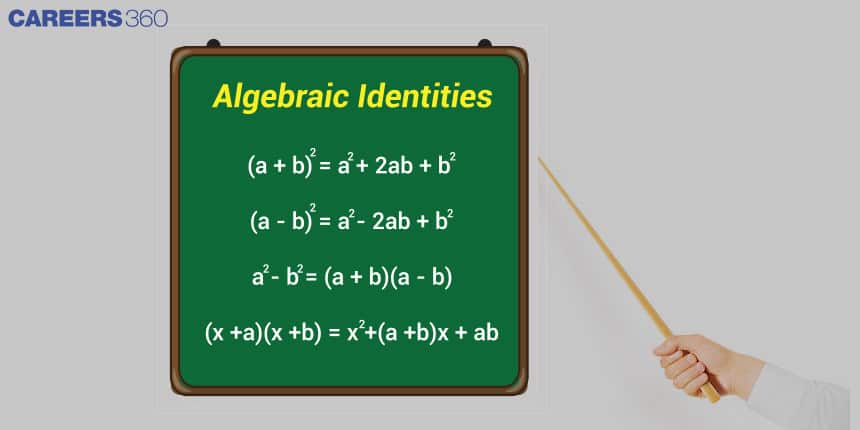Why Should I Learn The Identity Square Of (a+b)
Algebra is an important branch of mathematics that cannot be avoided in calculations. Students learn algebraic identities in NCERT Class 8 Mathematics and Other state board books. One of the important identities that high school students learn is (a+b)2=a2+b2+2ab. There may be a question: why should I learn this algebraic identity. Let us understand it through some examples.

Practical Example Of (a+b)2
You and your friend need to buy a cloth of the same colour and quantity but of different size. You need a cloth with a dimension of 8 x 8 and your friend needs a dimension of 10 x 10.The price per metre square is 100 rupees. You will need more clothes of approximately 160 square metre for decoration in the near future also. Shopkeeper said that the price of clothes will increase in the coming week. So buy 18 x 18. Which one would you prefer 18 x 18 or 8 x 8 and 10 x 10?
If price criteria is considered
Case: 1 - buying separately
Price of 8 x 8 = 6400
Price of 10 x 10 = 10000
Total = 16400
Case 2: Buy cloth of 18 x 18
Price of 18 x 18 = 32400
There is a good difference in price that is 32400-16400=16000
If we look at the dimensions. In the first case you are getting 164 square metres of cloth and which can be taken for present use only.
If case 2 is considered you get 324 square metres and can be used in the future.
So by looking at the dimension you have an excess of 324-164=160 square metres.
Option 1: You may think that the difference in price is high for now. Let me buy the cloth required for the future later.
Option 2: If I buy 18 x 18 I will get more clothes that I require later.
As prices will increase in the coming week option 2 is better if you look at the calculations and your needs. What is the basic mathematics used here? Why buying clothes of 8 x 8 and 10 x 10 is not equal to 18 x 18?
The basic idea is a2+b2 is not equal to (a+b)2. If a and b are positive (a+b)2 is always greater than a2+b2.
(a+b)2 =a2+b2+2ab. So (a+b)2 is greater than a2+b2 by 2ab.
How can this calculation be applied to the above situation?
82+102=164 m2
(8+10)2=82+102+2 x 8 x 10=164+160=324. Simply 182=324>164. This is how the identity is used in the calculation. If you are thinking using the algebraic identity the decision making in the above situation will be faster and there is no need for numeric calculation. Just the understanding that If a and b are positive (a+b)2 is always greater than a2+b2 is enough. This is one simple situation. Similarly we may use the algebraic identity in different situations. Main idea of algebraic identities is to make calculations easier.
How (a+b)2=a2+b2+2ab
(a+b)2=(a+b)(a+b)=a.a+ab+ba+b.b
=a2+ab+ba+b2
ab=ba
Therefore
(a+b)2=a2+ab+ab+b2=a2+2ab+b2=a2+b2+2ab
(a+b)2 In Theory
In theory while studying to find squares of terms near to 100 or 1000 this identity is useful.
For example 1102 without a calculator can be easily found using identity. As we know 1002 value and 102 value
110=100+10
1102=(100+10)2=1002+102+2 x 100 x 10=10000+100+2000=12100. This is one method. If you have in mind the value of 112 then it is very easy. The answer is directly 112 x 102=121 x 100=12100. Here the exponential property is used (ab)n=anbn. If you don't know the value of 112 then using (a+b)2 = a2+b2+2ab is preferred.
Similarly for 10802
We can write (1000+80)2=10002+802+2 x 1000 x 80
=1000000+6400+160000=1166400
Here using the algebraic identity the calculation is simplified. Basic algebra has different applications in our daily life. Here the discussion above is on the importance of (a+b)2. Similarly we study algebraic identities with examples in Class 8 NCERT Mathematics Chapter. Try to find out the uses of all algebraic identities discussed in the book and understand how calculation is simplified using algebraic identities.
Applications for Admissions are open.
As per latest syllabus. Physics formulas, equations, & laws of class 11 & 12th chapters
JEE Main Important Chemistry formulas
Get nowAs per latest syllabus. Chemistry formulas, equations, & laws of class 11 & 12th chapters
JEE Main high scoring chapters and topics
Get nowAs per latest 2024 syllabus. Study 40% syllabus and score upto 100% marks in JEE
JEE Main Important Mathematics Formulas
Get nowAs per latest syllabus. Maths formulas, equations, & theorems of class 11 & 12th chapters
